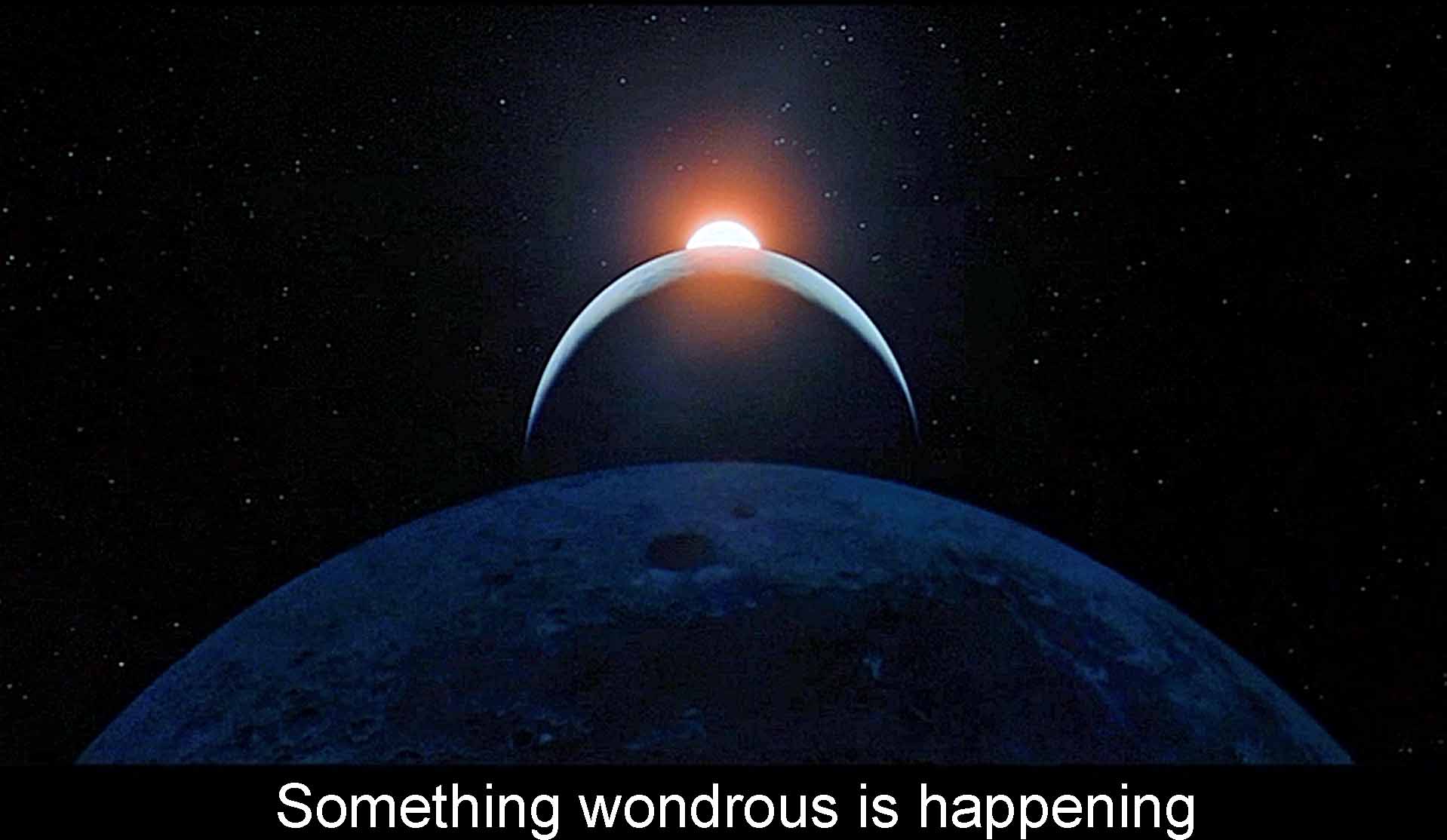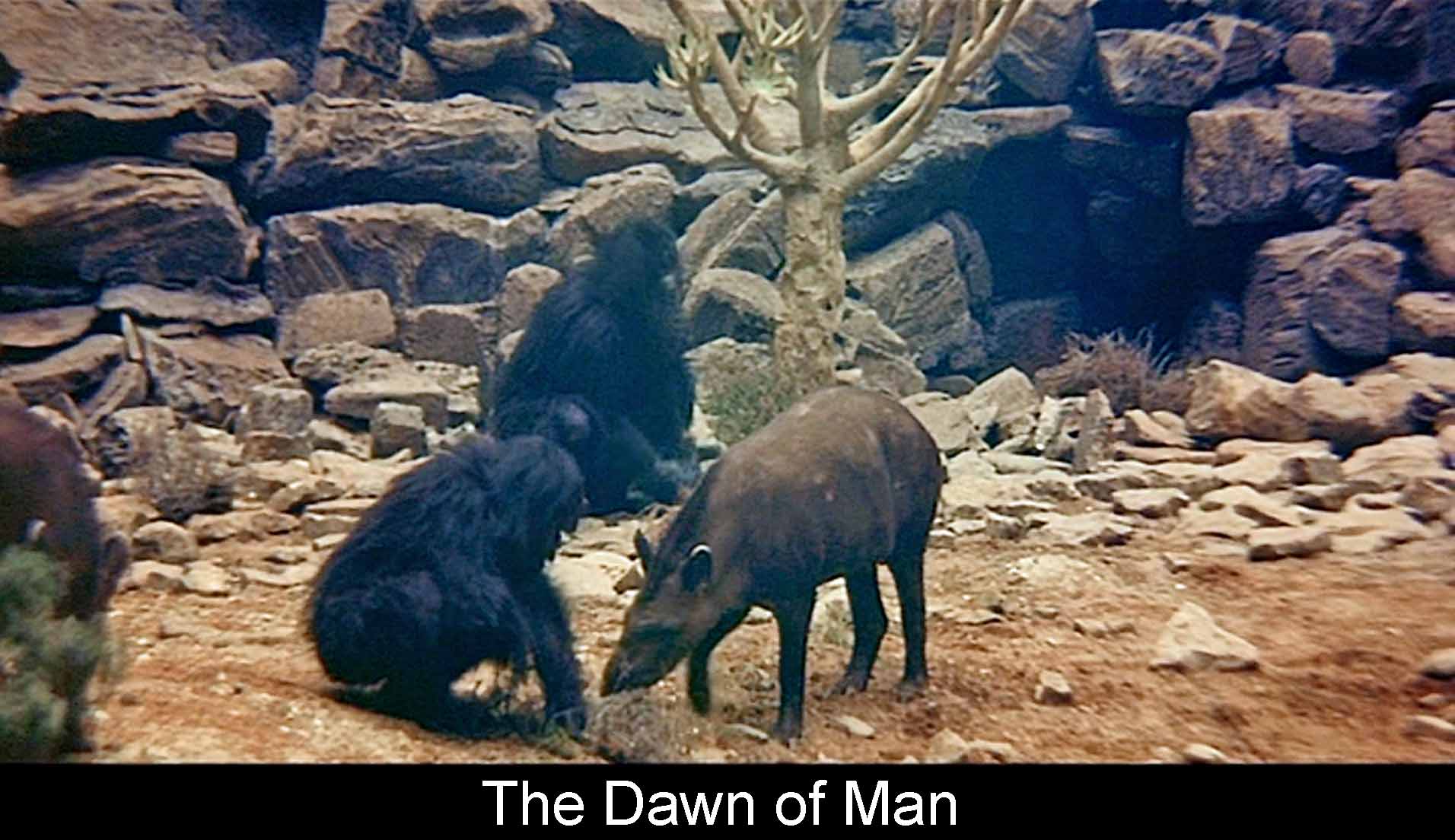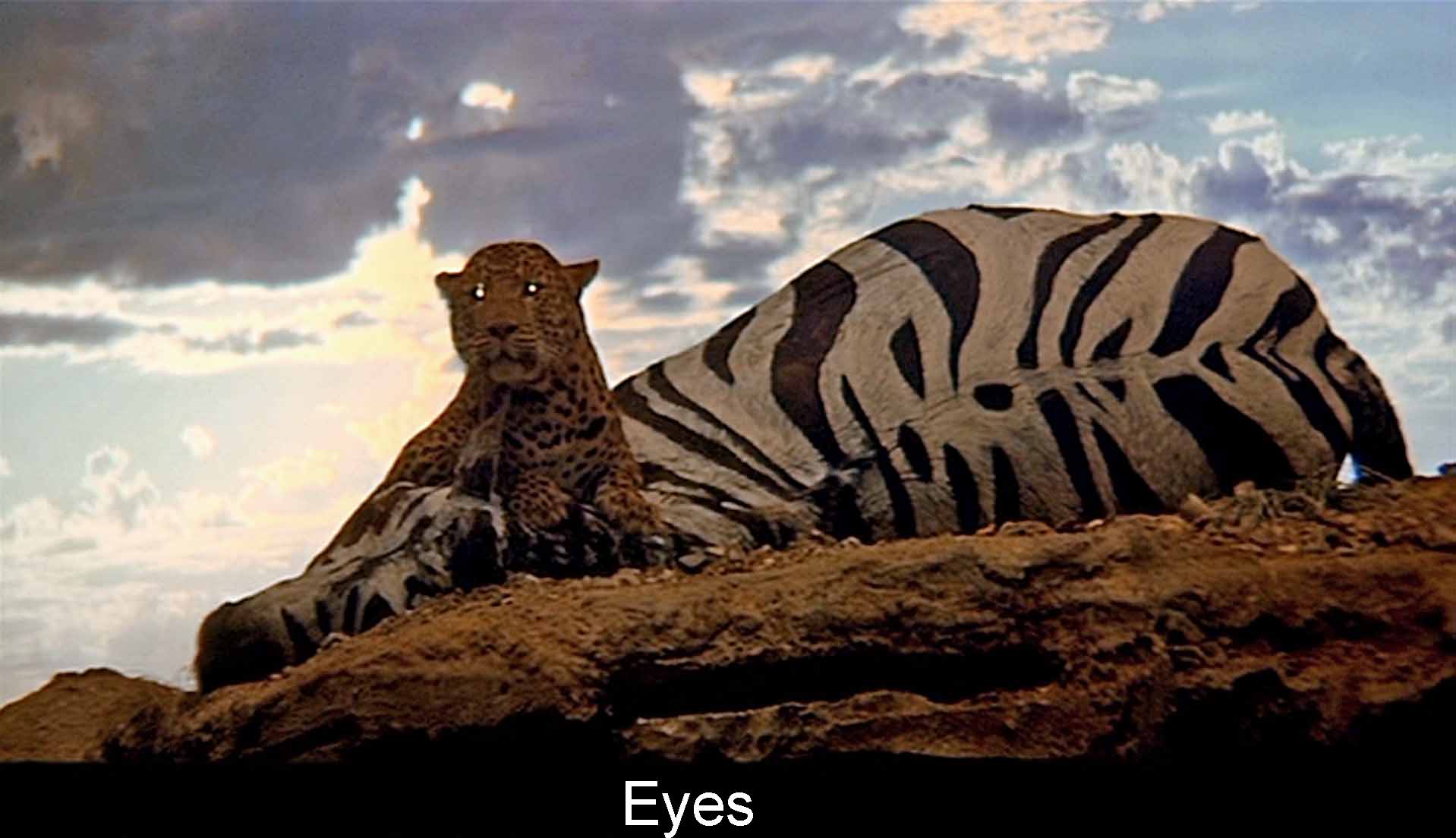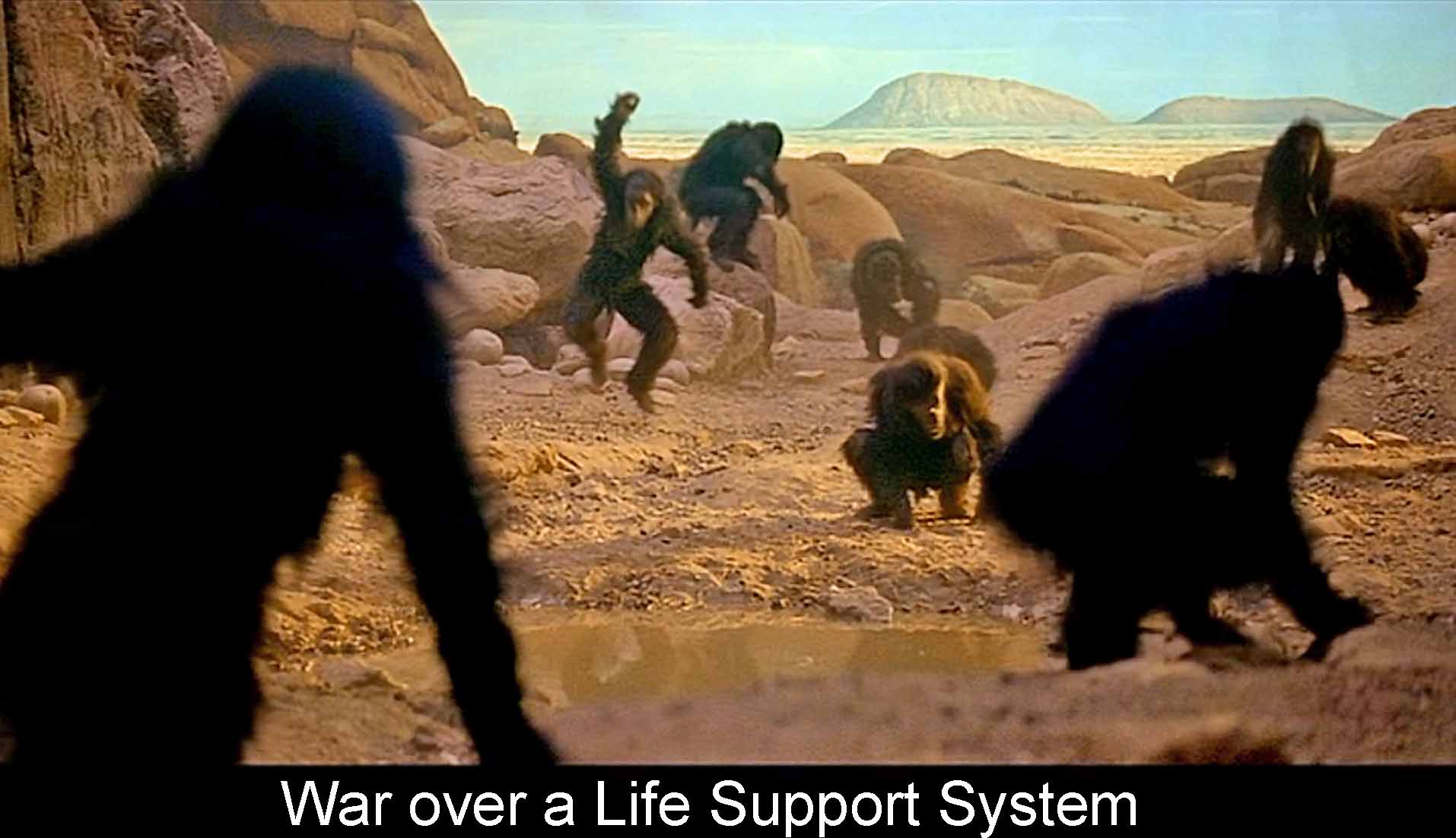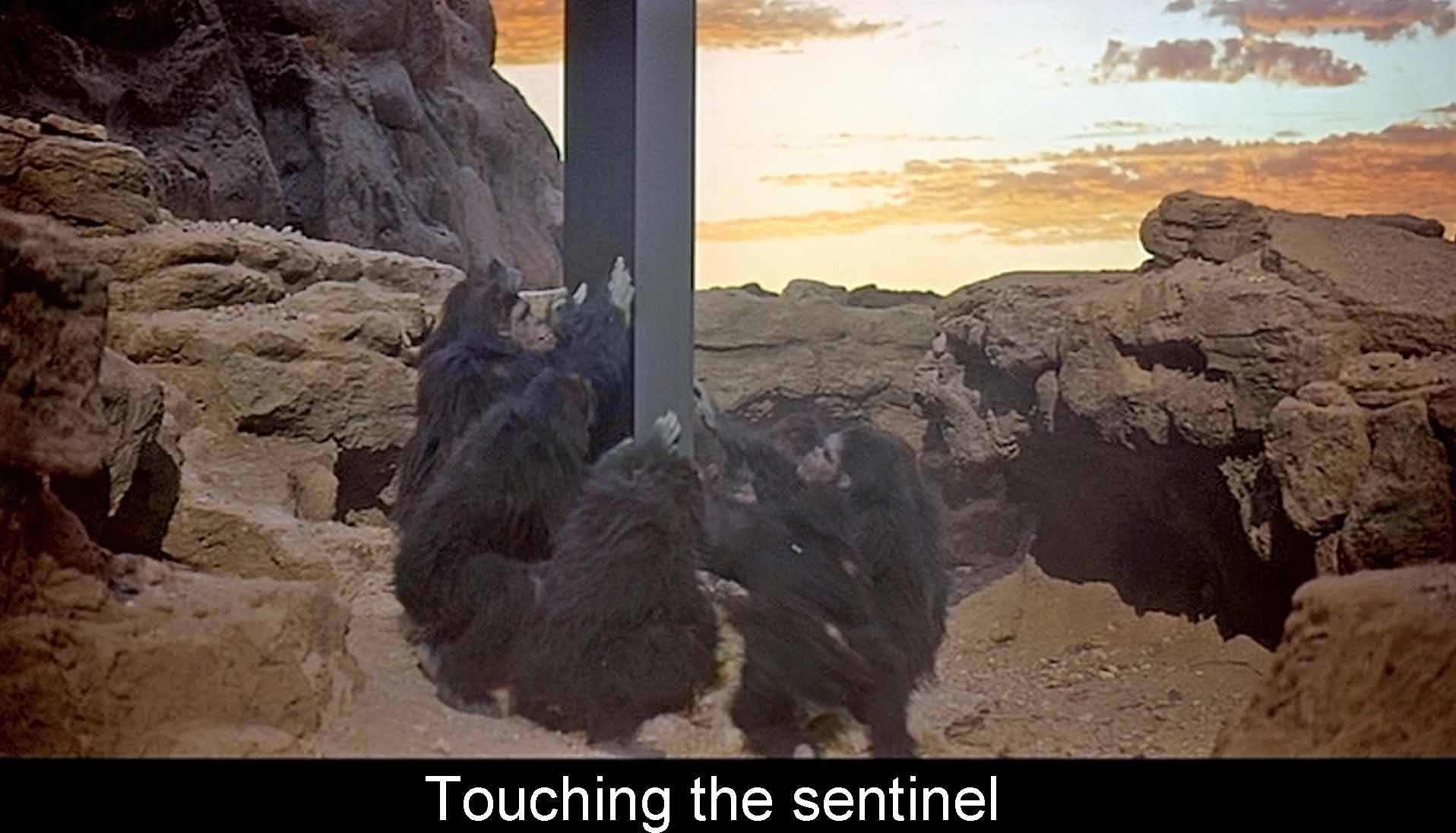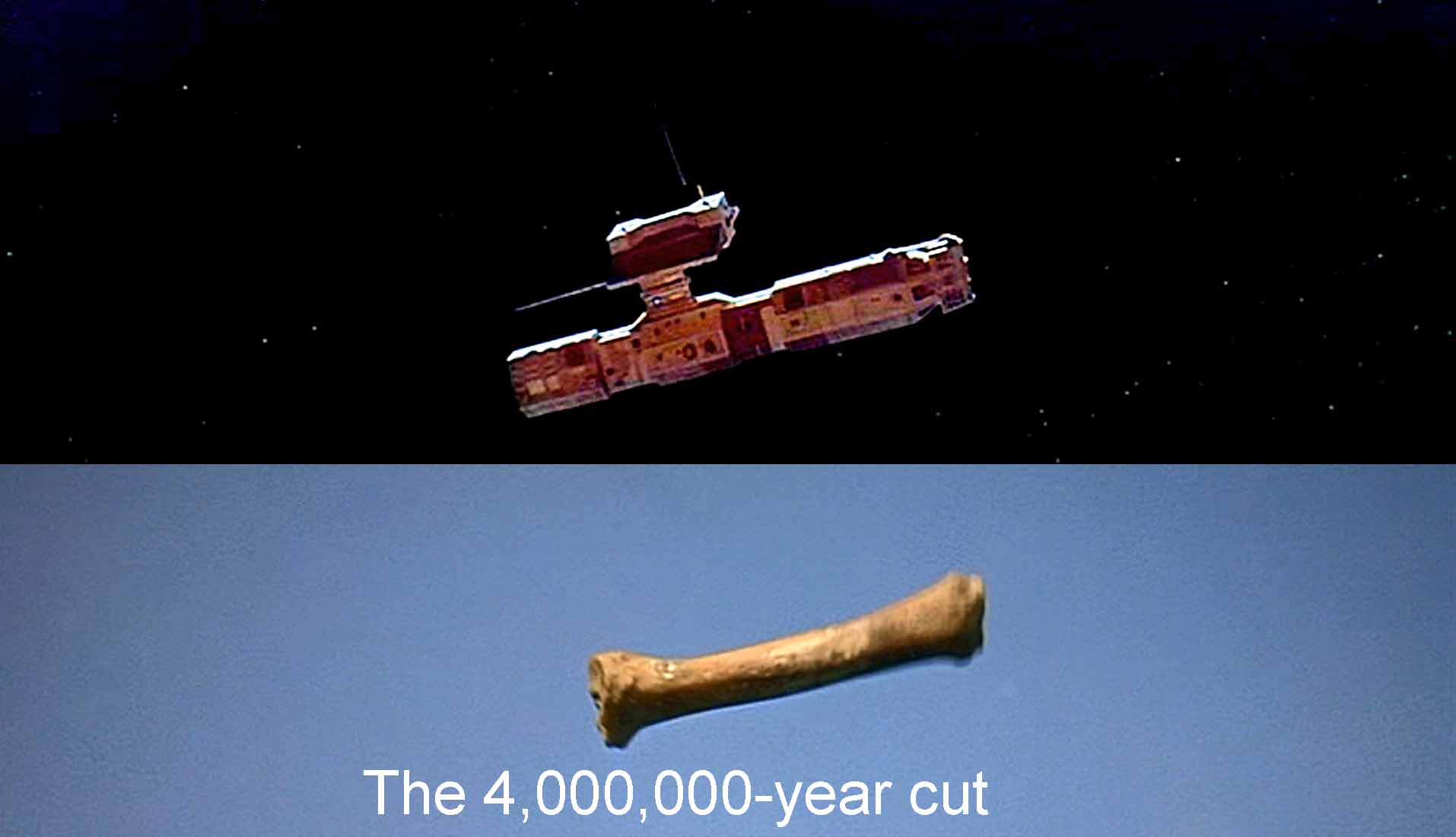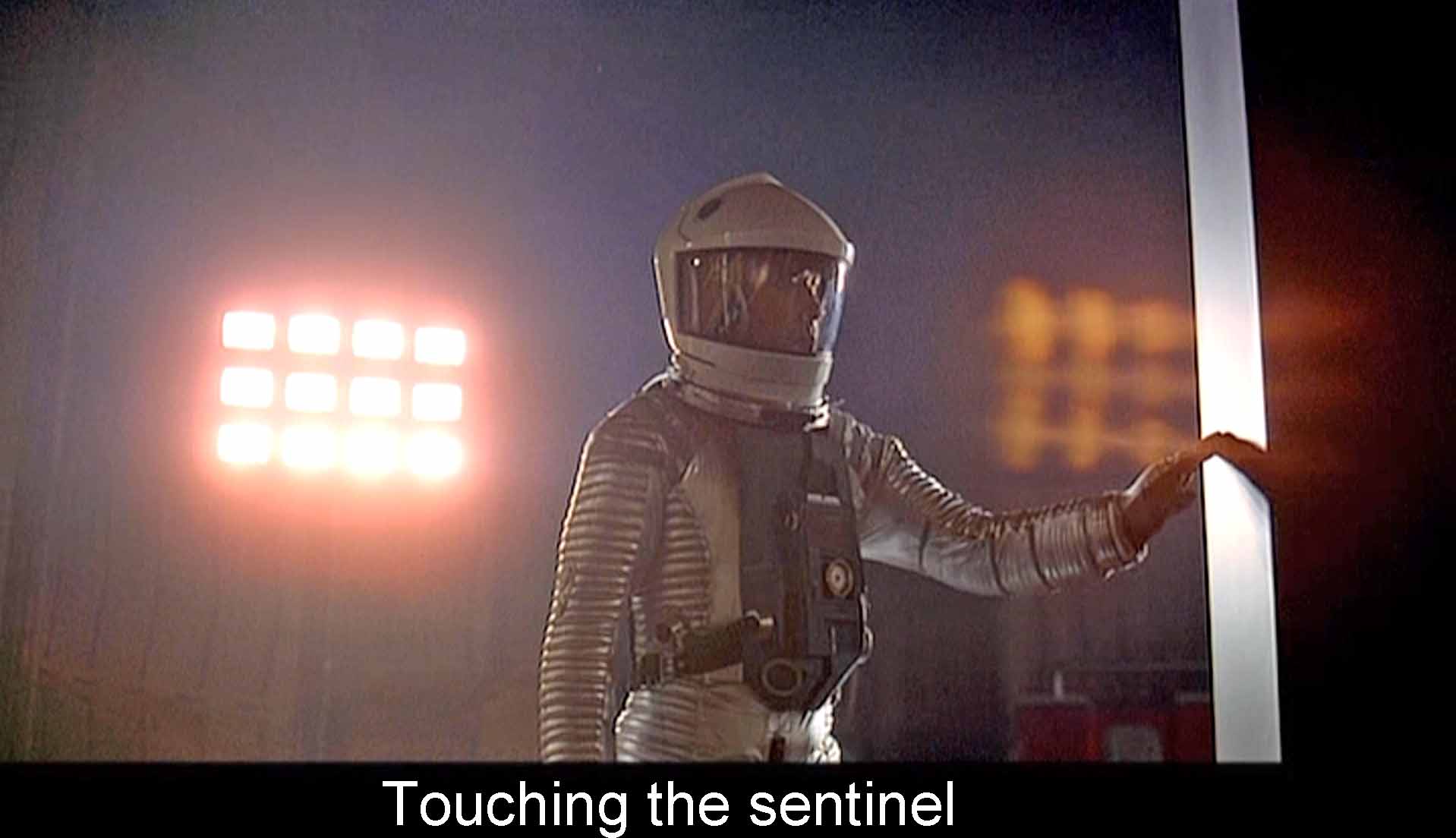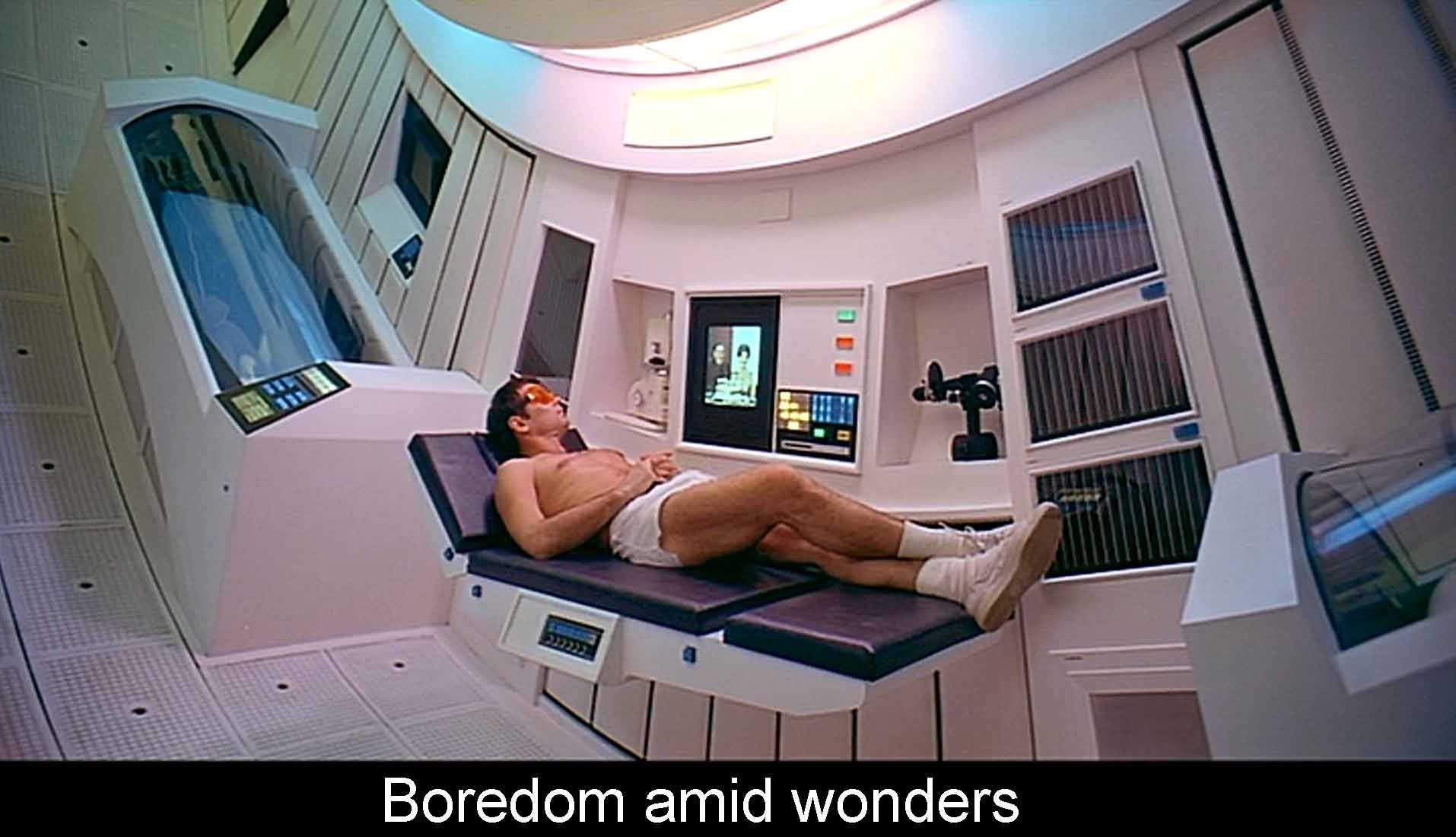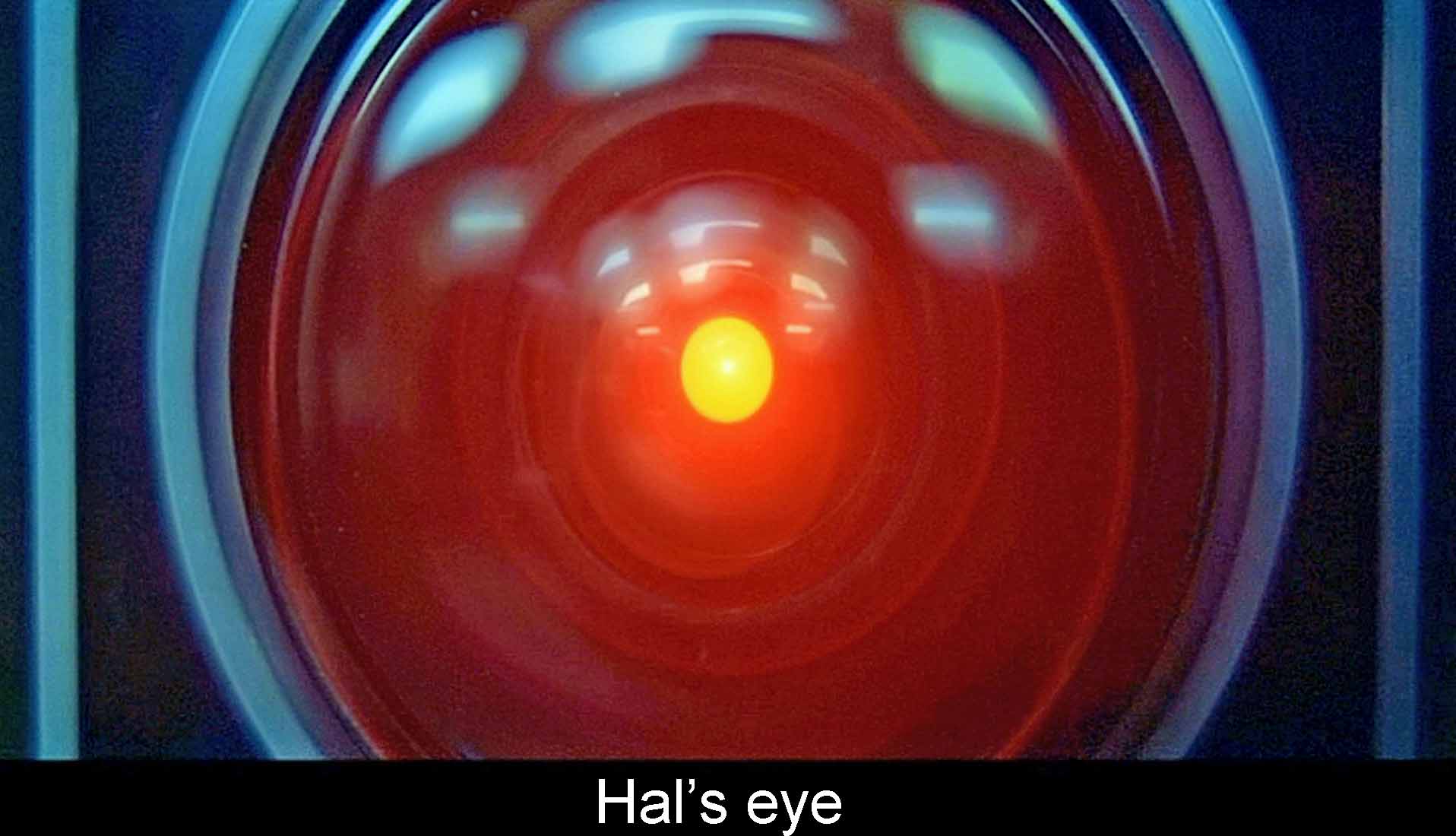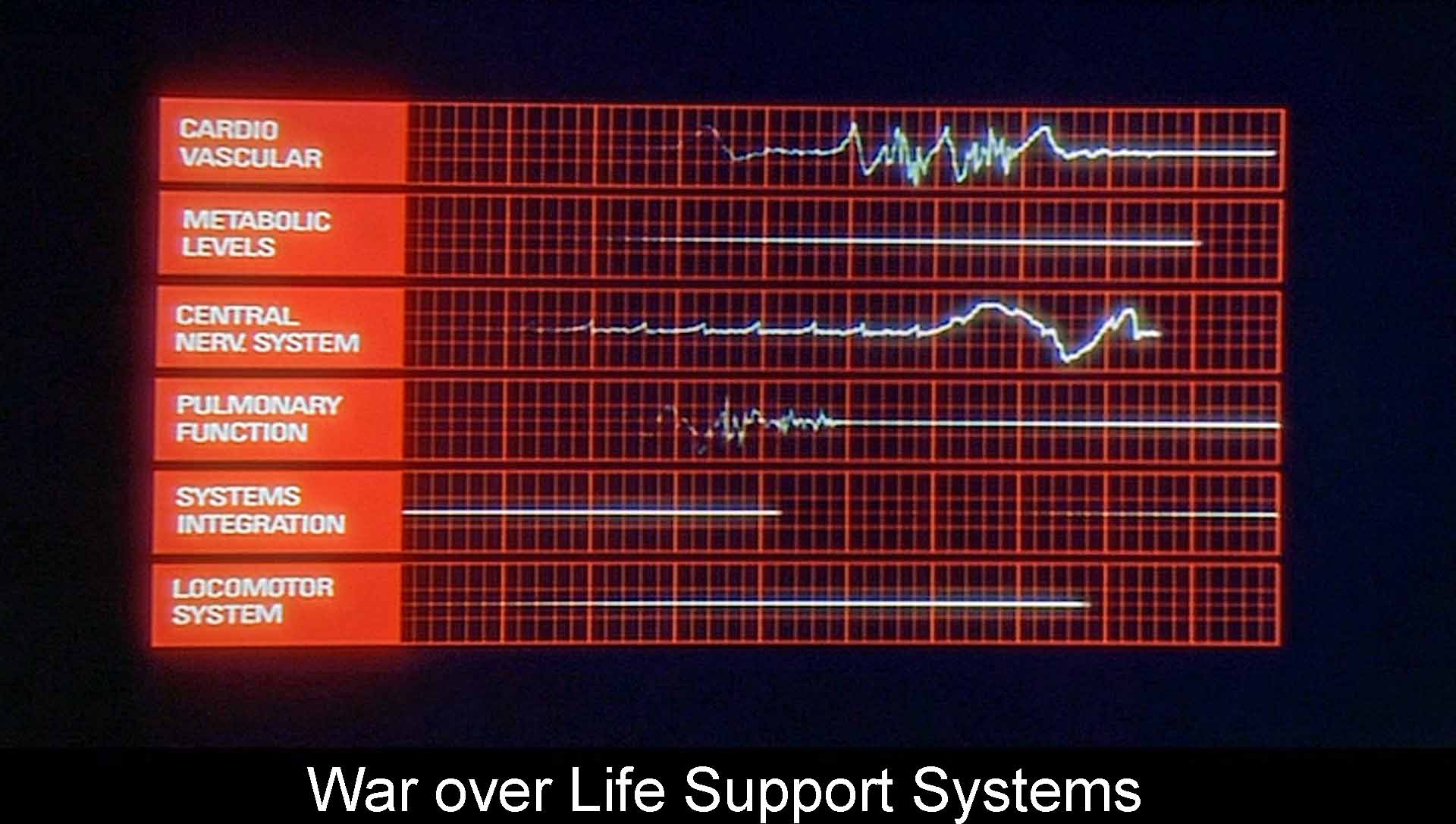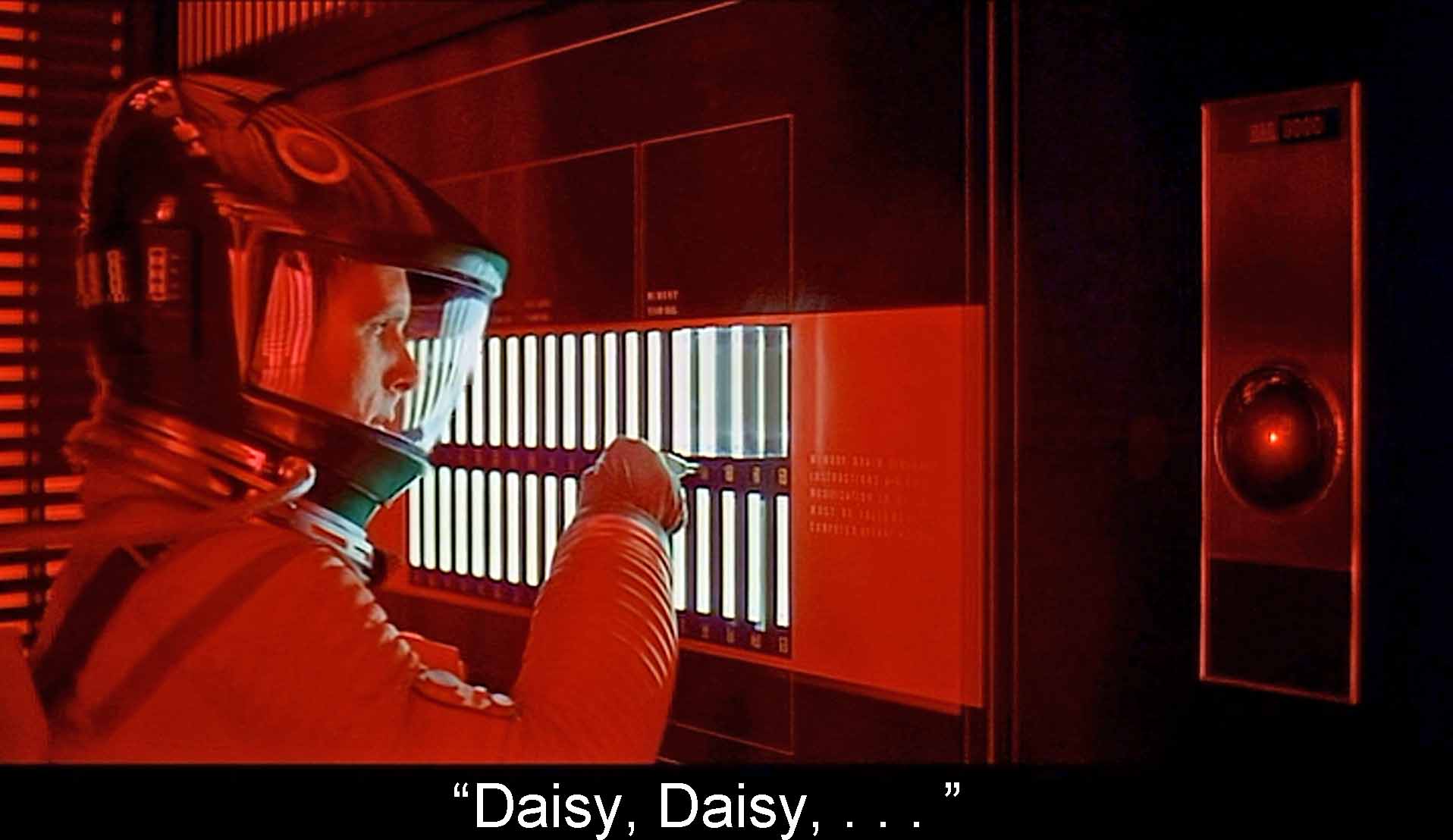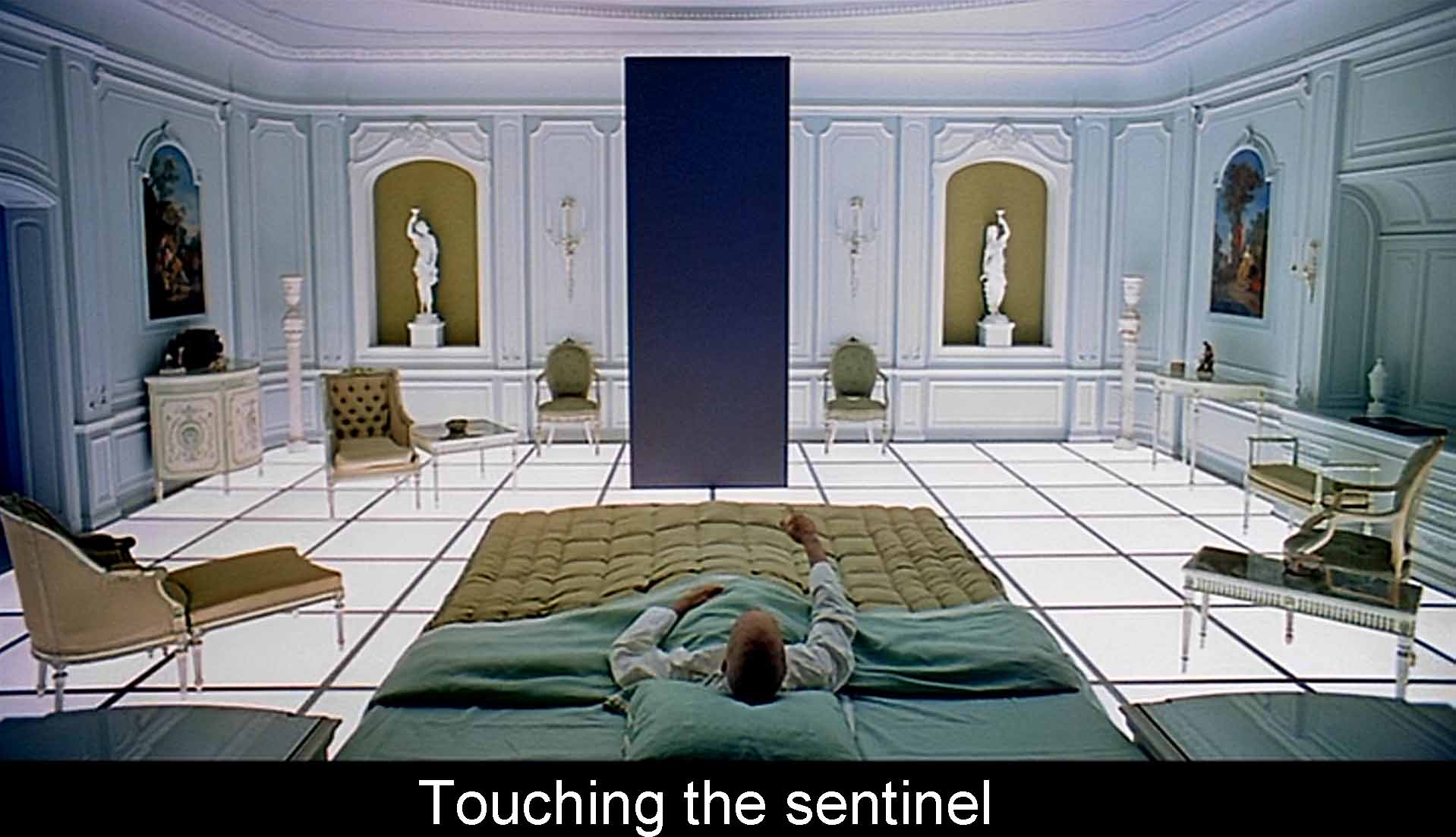“Life support systems.” If there is one phrase from the film that brings all the four phases of 2001 into the wholeness I like to find in even the most far-out works of art, that's it: “life support systems.” The mysterious appearances of the slabs (or in the name given them in the Arthur C. Clarke story on which part of 2001 is based) the “sentinels”—these mark out the four stories or chapters that make up the film. The action of each is a contest over a life support system. The enigmatic image that ends the film is the finest life support system of them all, the totally sustaining amnion from which that wide-eyed fetus, the Star-Child, stares at Earth.
The opening episode with the proto-human apes, hominins, sets the pattern. They live in a tribe, males guarding and females suckling the young. For a life-support system (apart from the suckling), these hominins have a bleak, scarred landscape with one particularly vital waterhole. They compete for food in this landscape with a rival tribe of hominins, a marauding leopard, and what look to me like tapirs. (Tapirs and apes do not inhabit the same parts of our globe today, but this is millions of years ago, so who cares?) The two tribes of hominins compete for the waterhole. Each tribe tries to withhold the system from the other, by frightening them away with shrieks and babble.
Finally, the slab appears, and at just the right conjunction of the planets the hominins' touching it mysteriously triggers an intellectual discovery. The lead ape-man of one tribe (Daniel Richter) figures out how to use a bone for a weapon so he can slug and kill a tapir for food. Then he slugs and kills the lead ape of the other group and so takes the drinking space away from the defeated tribe. There is a kind of exquisite slow-motion symphony of bones as the delighted ape, now homo habilis if not yet sapiens, bangs away with a convenient femur, sending the rest of the bones spinning ever so slowly skyward. This slow motion becomes Kubrick’s cinematic symbol for all the film’s subsequent ramifications of man’s outward, tool-using drives.
This first, hominin chapter defines the pattern. It has eight elements, not necessarily in this order. Each chapter begins with (1) a life support system, particularly one associated with (2) drinking or slurping food and with (3) parent-child relationships), and (4) an image of eyes. There follows (5) a struggle between two individuals or groups for that lifespace, (6) meaningless babble or other failure of communication, (7) the intervention of the slab/sentinel, and finally (8) victory for one side or the other, leading to a new evolutionary phase.
The film abruptly makes a legendary match cut through four million years to a bone-white orbiting nuclear weapon. From there, the film cuts to a space shuttle carrying a NASA official, Dr. Heywood R. Floyd (William Sylvester) to the international space station. The music has shifted from Strauss' Also Sprach Zarathustra accompanying the excitement of the hominins' discovery of a tool to a Strauss waltz, suggesting how easy and graceful it all seems—now. And boring: Dr. Floyd sleeps through this flight that today (2012) people pay hundreds of thousands of dollars to enjoy.
The sudden jump from tool-using hominin to the achievement of space travel, a leap to which the Strauss music/waltz is improbable but perfect accompaniment, conveys once and for all the dominant emotional mode of the film: that fine frenzy of total optimism that only the scientist can know and against which the film will play humanity’s succession of less-than-total triumphs. And sections 2, 3, and 4 will all contrast humans’ boredom with the excitement of our simian forebears in episode 1.
The moonship is, more than anything else, a life-support system because of the special effects that we and Kubrick both delight in: the tv dinners coming out of Automat slots; the drinks in their plastic containers; the flight attendant going through airlocks and body inverters; finally, the space toilet with its immense set of instructions for dealing with excrement in its weightless state. (Reminds me of the Hungarian instructions I encountered on a train out of Budapest.) Still more life support comes in the docking station and the Space Hilton that supplies the bland, pre-fabricated plastic substances that seem to define the quality of our life for the foreseeable future. Here the parent-child motif occurs as the NASA man makes a long-distance call from the space station to his daughter on earth. Here, too, comes the confrontation between the two rival groups of hominins over the drinking place: the American and a group of Russians cold warring across a cocktail table. The issue is, will the American tell what is going on at the moon station?
Security becomes the battleground (as, in a way, it had been for the apes). But now it’s not shrieks and chatter, but voice-identification machines and, finally, the delightful “briefing” of the progressive group among the scientists in the moon station. They would like to tell the world about the slab they have found. The NASA man who has been sent out from Washington immediately puts this naive notion to rest in a stream of faceless, falsely hearty bureaucratic jabber, the gist of which is, Papa knows best—We aren’t telling, and you can like it or lump it. But stated in the suave, manipulative jargon of Modern Management Methods—one has to have sat through a couple of these NASA or other government briefings to appreciate the delicate needlepoint of this parody, even to the fawning virility of the subordinates after the briefing is over—“ That was a fine talk!” In any case, it is the meaningless babble in the plot of the second phase. A trip to the station on the moon brings us again to the slab, this time seen as a device created by intelligent beings but buried underground centuries before there could have been any intelligent—or bureaucratic—beings on the moon. It sends a powerful radio signal pointing to Jupiter.
As a result of the NASA man’s touching the slab, new knowledge spreads and sets in motion, not a bone now, but a vast expedition to one of Jupiter’s moons involving a gigantic space ship and all kinds of new space methods, particularly the keeping of part of the crew in hibernation. Unfortunately, the cutting just at this point gets too abrupt. Kubrick apparently called back the prints of 2001 after the New York opening to shorten the film at precisely this juncture. The effect is to obscure motivations almost entirely. Apparently, however, the Jupiter expedition seeks to follow, wherever it might lead, the trail of the mysterious slabs (which look, for all the world, like little UN buildings).
The “life support system” in this third phase of the film is, again, the space ship itself, directed by the fabulous computer HAL (voiced by Douglas Rain), which feeds, waters, and in general nurtures both the hibernating and the two ambulatory astronauts. They are Dr. Frank Poole (note the name; played by Gary Lockwood) and Dr. Dave Bowman (again, note the name: Keir Dullea). Parents appear on television, transmitting birthday greetings to Poole, their massively bored astronaut-son. The “babble” part of the recurring motifs consists of HAL’s ceaseless flashing of information to the astronauts that they cannot deal with themselves—they can only turn helplessly back to HAL. Then there is Dr. Floyd’s recorded message about the purpose of the mission—more security and bureaucratic prose.
As in the other chapters, two “groups” quarrel over the life support system, the human astronauts and HAL. The struggle takes the form of withholding: HAL kills off the hibernating astronauts, removing their life support systems. He or “it” manages to cut Poole’s air supply line while he’s outside the vehicle, and Poole dies. HAL then very nearly succeeds in leaving Bowman stranded in space. He, however, manages to force his way back into the mother ship and performs an electronic lobotomy on the computer.
It is perhaps the only emotional moment in this technologically dazzling film. As Bowman disables one after another of his modules, HAL begs for mercy:
HAL: I’m afraid. I’m afraid, Dave. Dave, my mind is going. I can feel it. I can feel it. My mind is going. There is no question about it. I can feel it. I can feel it. I can feel it. I’m a... fraid.
Good afternoon, gentlemen. I am a HAL 9000 computer. I became operational at the H.A.L. plant in Urbana, Illinois on the 12th of January 1992. My instructor was Mr. Langley, and he taught me to sing a song. If you’d like to hear it I can sing it for you.
Bowman: Yes, I’d like to hear it, HAL. Sing it for me.
HAL: It’s called “Daisy.”
[sings while slowing down]
HAL: Daisy, Daisy, give me your answer do. I’m half-crazy all for the love of you. It won’t be a stylish marriage, I can’t afford a carriage. But you’ll look sweet upon the seat of a bicycle built for. . . two.
As a psychological critic, I’m fascinated that we can feel sympathy for a computer and a murderous computer at that. And the choice of “A Bicycle Built for Two” when we are in this huge circular space ship, built for the two un-hibernated astronauts—what imagination!
As Bowman is destroying HAL’s higher brain systems, the slab/sentinel appears out in space, and planets and moons align themselves. But in this third chapter of the film, when Bowman in his extra-vehicular pod tries to touch it, the slab the film goes wild. As we transition to the fourth chapter, the slab triggers for its discovery, a psychedelic, ten-minute trip through shapes and sounds and Day-Glo landscapes, an incredible race through time that brilliantly contrasts with the earlier hard-edged slow motion. The last shot before we resume story is an eye.
Alas, the psychedelic trip seems to serve only to send this last remaining astronaut, now visibly aged, to what looks like the Jupiter Hilton; anyway, a suite decorated in a motel owner’s notion of Louis XVI style. In interviews in Playboy and eye, after the film’s release, Kubrick said that this apartment is some kind of museum or zoo. It exists only in the astronaut’s imagination, hence its kitsch decor; but I could see no way of knowing this from the film itself. Chapter 4 is, quite simply, mysterious, especially given its treatment of time. Chapters 2 and 3 dealt with the conquest of space. Chapter 4 deals with the conquest of space-time.
In this chapter, as if to emphasize the suite’s role as a life support system, we hear Bowman’s breathing, echoing as it did in his extra-vehicular pod. Interestingly, there is nothing in the suite to occupy the mind, no books, magazines, tv, games—-nothing. The two “groups” competing for this lifespace are the two incarnations of this one astronaut. The first shot shows the extra-vehicular pod in the suite. Bowman steps out of it in his space suit, but now he is middle-aged. He walks through the suite like someone checking out a new hotel room—yes, the bathroom is ok. He sees in another room—himself, a decade older. He is wearing a dressing gown and eating at a room service trolley. This new Bowman checks for the other, earlier one, but doesn’t see him. New Bowman drops a wine glass, breaking it and echoing the broken bones the ape-man scattered in chapter 1. He is, in effect, his own parent, carrying out that motif, and one of the incarnations, drinking wine, recalls the scene at the original waterhole. Then, this elderly Bowman sees again, across the room, a still older Bowman. There are incoherent electronic sounds in the background, the “babble.” I’m not sure what the weapons are in this fourth chapter; but, clearly, what is being withheld in this life support system is immortality or timelessness.
As each version of himself sees a new, older self, the younger one disappears, until we are left with a pathetic, bedridden, dying old man. At the foot of the bed, the slab appears, and he reaches up to touch it as the ape-man had done, as Dr. Floyd had done, as Bowman tried to do. Immediately, the old man transforms into the final image, a fetus staring at planet Earth out of his amniotic sac. His eyes are huge, echoing the eye that introduced chapter 4 and all the eyes before it. Here, at last, is wonder, after all the boredom among technological wonders. The fetus stares at our beautiful, blue, and much-abused Earth. It wonders. Can we?
The Star-Child, as the script calls him, is thoroughly ambiguous. One cannot tell whether the fetus has become a planet, a world unto itself, or whether it is floating back to earth, a new Messiah, who, reborn, will tell the rest of us, stuck in Plato’s cave, of its blinding experience. The first three episodes or chapters have to do with the conquest of space, the last with the conquest of space-time. Bowman does not die; he is reborn. This is an odyssey, and this man is returning home; Man is returning home. The Star-Child stares wide-eyed at the marvel of planet Earth—and, in the last moment of the film, at the marvel of us, the “home” of this film. Will we, can we wonder?
To put that quite another way, the first three chapters, beginning with the phallic bone-wielding of the ape-man and going on through the rocket ship’s penetrating the intricately female docking stations and Bowman’s extra-vehicular pod penetrating HAL’s space ship—the first three chapters deal with the mastery of outer space. The last, beginning with the psychedelic imagery, deals with the mastery of inner space. Does one turn outward for a life support system? Or inward?
Frankly, although it perfectly ends the film completing the pattern that runs through the four chapters, I cannot find a definite answer in that last image. Its meaning quite eludes me. Are we to take the final message of the slabs to be that we have been running in the wrong direction all this time, ever since the first ape-man grabbed up the first tool? That we have foolishly been trying to discover and conquer outer worlds, when we should have been seeking psychedelic discoveries in innerspace that would let us be worlds unto ourselves, peaceful fetuses, dependent on no outside life support system? Kubrick made the film in 1968, after all, the heyday of hippitude and experimentation with mind-altering drugs.
In its last chapter and the lead-up to it, 2001 tempts us with a trip inward, a more primitive, more immediate and total gratification of impulses, more overwhelmingly pleasurable, than any journey to Jupiter. We just have to become watchers. We need to recapture wonder and get past the boredom so evident in the two middle chapters of the film.
If so, then the ending suggests that all the gorgeous technology that formed the entrancing middle of the film was futile. The psychedelic trip blows our minds and restores us to wonder—the wide-eyed Star-Child. The slow-motion, hard-edged scientific imagery of the rockets led only to boredom and indifference. What looks like progress isn’t. If so, the ending is downbeat. The way we are living and trying to grow won’t work. But Kubrick said, after the film was released, he thought he had made an optimistic picture about rebirth and a new Messiah (thereby justifying reviewer John Simon’s outrageous pun, that this is “a shaggy God story”).
Which life support system will we be living in in our future, now that 2001 itself is long past? Endless outward exploration? Or passively being nurtured in a world beyond our understanding? The ambiguity of Kubrick’s ending is the ambiguity of the future itself. The film seems to me sufficiently ambiguous so that I could sustain either the optimistic but fanciful rebirth or the more realistic but pessimistic anti-scientific view. Or both.
That ambiguity, that openness to our own imaginations despite the overpowering visual experience of 2001: A Space Odyssey, is perhaps what makes this so great a film. And a great film it is, as proven by the way film buffs (like me) have come back to it again and again, always seeing and finding and feeling something new. Kubrick said he wanted to restore us to wonder, and with this film he did. A work of art, to be great, should live for a century, and 2001 is surely doing that and, whatever our future, it will doubtless claim our wonder even longer.
